Source(google.com.pk)
Kite Biography
Kite traction
A quad-line traction kite, commonly used as a power source for kite surfing
Kites can be used to pull people and vehicles downwind. Efficient foil-type kites such as power kites can also be used to sail upwind under the same principles as used by other sailing craft, provided that lateral forces on the ground or in the water are redirected as with the keels, center boards, wheels and ice blades of traditional sailing craft. In the last two decades several kite sailing sports have become popular, such as kite buggying, kite landboarding, kite boating and kite surfing. Snow kiting has also become popular in recent years.
Kite sailing opens several possibilities not available in traditional sailing:
Wind speeds are greater at higher altitudes
Kites may be manoeuvered dynamically which increases the force available dramatically
There is no need for mechanical structures to withstand bending forces; vehicles or hulls can be very light or dispensed with all together
The German company SkySails has developed ship-pulling kites as a supplemental power source for cargo ships, first tested in January 2008 on the ship MS Beluga Skysails.[35] Trials on this 55 m ship have shown that, in favorable winds, the kite reduces fuel consumption by up to 30%. This system is planned to be in full commercial production late 2008.[36] Kites are available as an auxiliary sail or emergency spinnaker for sailing boats. Self-launching Parafoil kites are attached to the mast.[citation needed]
MS Beluga Skysails is the world's first commercial container cargo ship partially powered by a giant computer-controlled kite (160 m² or 1,722 sq ft). The kite could reduce fuel consumption by 20%. It was launched on 17 December 2007 and was set to leave the northern German port of Bremerhaven to Guanta, Venezuela on January 22, 2008. Stephan Wrage, managing director of SkySails GmbH announced: "During the next few months we will finally be able to prove that our technology works in practice and significantly reduces fuel consumption and emissions." Verena Frank, project manager at Beluga Shipping GmbH, SkySails GmbH's partner further stated that "the project's core concept was using wind energy as auxiliary propulsion power and using wind as a free of charge energy".[37]
Power generation
See also: laddermill and High altitude wind power
Conceptual research and development projects by over a hundred entities are investigating the use of kites in harnessing high altitude wind currents to generate electricity.[38]
Delft University of Technology is developing a kite power technology demonstrator system based on a 25 m² kite generating 20 kW mechanical traction power. The system is tested regularly since January 2010.[39]
At the Katholieke Universiteit Leuven a research group is investigating the use of kites for power generation. Rather than a flexible kite, they use a rigid structure like an aircraft wing, because of its greater aerodynamic efficiency, easier control, and more predictable dynamics. A small prototype is being built.[40]
Cultural uses
Launch of ram-air inflated Peter Lynn single-line kite, shaped like an octopus and 90 feet (27 m) long.
Kite festivals are a popular form of entertainment throughout the world. They include large local events, traditional festivals which have been held for hundreds[clarification needed] of years and major international festivals which bring in kite flyers from Britain to display their unique art kites and demonstrate the latest technical kites.
Asia
Making a traditional Wau jala budi kite in Malaysia. The bamboo frame is covered with plain paper and then decorated with multiple layers of shaped paper and foil.
Kite flying is popular in many Asian countries, where it often takes the form of 'kite fighting', in which participants try to snag each other's kites or cut other kites down.[41] Fighter kites are usually small, flat, flattened diamond-shaped kites made of paper and bamboo. Tails are not used on fighter kites so that agility and maneuverability are not compromised.
In Afghanistan, kite flying is a popular game, and is known in Dari as Gudiparan Bazi. Some kite fighters pass their strings through a mixture of ground glass powder and glue, which is legal. The resulting strings are very abrasive and can sever the competitor's strings more easily. The abrasive strings can also injure people. During the Taliban rule in Afghanistan, kite flying was banned, among various other recreations.
In Pakistan, kite flying is often known as Gudi-Bazi or Patang-bazi. Although kite flying is a popular ritual for the celebration of spring festival known as Jashn-e-Baharaan (lit. Spring Festival) or Basant, kites are flown throughout the year. Kite fighting is a very popular all around Pakistan, but centered in urban centers across the country especially Lahore. The kite fights are at their maximum during the spring celebrations and the fighters enjoy competing with rivals in which one have to cut-loose the string of the kite of other, this is popularly called as "Paecha". During the spring festival, kite flying competitions are held across the country and the skies are colored with kites. As people cut-loose an opponents kites, shouts of 'wo kata' ring through the air. Reclaiming the kites, after they have been cut-loose by running after them, is a popular ritual especially among the youth (similar to scenes depicted in the Kite Runner which is based in neighboring Afghanistan). Kites and strings are a big business in the country and many types of strings are used: glass-coated strings, metal strings and tandi. However, kite flying was recently banned in Punjab due to recent motorcyclist deaths caused by glass-coated or metal kite-strings. Kup, Patang, Guda, and Nakhlaoo are some of the kites used. They vary in balance, weight and speed through the air.
In Vietnam, kites are flown without tails. Instead small flutes are attached allowing the wind to "hum" a musical tune. There are other forms of sound-making kites. In Bali, large bows are attached to the front of the kites to make a deep throbbing vibration, and in Malaysia row of gourds with sound-slots are used to create a whistle as the kite flies.[42]
A kite shop in Lucknow, India
Kites are very popular in India, with the states of Bihar, Jharkhand, Gujarat, West Bengal, Rajasthan and Punjab notable for their kite fighting festivals. Highly maneuverable single-string paper and bamboo kites are flown from the rooftops while using line friction in an attempt to cut each other's kite lines, either by letting the cutting line loose at high speed or by pulling the line in a fast and repeated manner. During the Indian spring festival of Makar Sankranti, near the middle of January, millions of people fly kites all over northern India. Kite flying in Hyderabad starts a month before this, but kite flying/fighting is an important part of other celebrations, including Republic Day, Independence Day, Raksha Bandhan, Viswakarma Puja day in late September and Janmashtami. An international kite festival is held every year before Uttarayan for three days in Vadodara, Surat and Ahmedabad.
Bermuda kite.
Weifang, Shandong, China is the kite capital of the world. China is the oldest place, probably with India where kites have been flown since antiquities. It is home to the largest kite museum in the world, the thousands of kites here have a display area of 8100 m2. Weifang hosts an annual international kite festival on the large salt flats south of the city. There are several kite museums in Japan, UK, Malaysia, Indonesia, Taiwan, Thailand and the USA.
In the olden days, Malays in Singapore, kites were used for fishing.[43]
Europe
In Greece and Cyprus, flying kites is a tradition for Clean Monday, the first day of Lent. In the British Overseas Territory of Bermuda, traditional Bermuda kites are made and flown at Easter, to symbolise Christ's ascent. Bermuda kites hold the world records for altitude and duration. In Fuerteventura a kite festival is usually held on the weekend nearest to 8 November lasting for 3 days.
Polynesia
Māori kite
Polynesian traditional kites are sometimes used at ceremonies and variants of traditional kites for amusement. Older pieces are kept in museums.
South America
In Chile, it is very popular, especially during Independence Day festivities (September 18).
In Colombia kites can be seen flown in parks and recreation areas during August which is known to be windy. It is during this month that most people, especially the young ones would fly kites.
In Guyana, kites are flown at Easter and is an activity participated in by all ethnic and religious groups. Kites are generally not flown at any other time of year. Kites start appearing in the sky in the weeks leading up to Easter and school children are taken to parks for the activity. It all culminates in a massive airborne celebration on Easter Monday especially in Georgetown, the capital, and other coastal areas. The history of the practice is not entirely clear but given that Easter is a Christian festival, it is said that the flying kite is symbolic of the Risen Lord. Moore[44] describes the phenomenon in the 19th century as follows:
A very popular Creole pastime was the flying of kites. Easter Monday, a public holiday, was the great kite-flying day on the sea wall in Georgetown and on open lands in villages. Young and old alike, male and female, appeared to be seized by kite-flying mania. Easter 1885 serves as a good example. “The appearance of the sky all over Georgetown, but especially towards the Sea Wall, was very striking, the air being thick with kites of all shapes and sizes, covered with gaily coloured paper, all riding bravely on the strong wind"
(His quotation is from a letter to The Creole newspaper of December 29, 1858). The exact origins of the practice of kite flying (exclusively) at Easter are unclear. Brereton and Yelvington[45] speculate that kite flying was introduced by Chinese indentured immigrants to the then colony of British Guyana in the mid 19th century. The author of an article in the Guyana Chronicle newspaper of May 6, 2007 is more certain:
Kite flying originated as a Chinese tradition to mark the beginning of spring. However, because the plantation owners were suspicious of the plantation workers, the Chinese claimed that it represented the resurrection of Jesus Christ. It was a clever argument, as at that time, Christians celebrated Easter to the glory of the risen Christ.



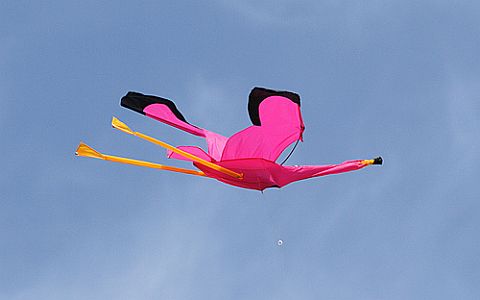
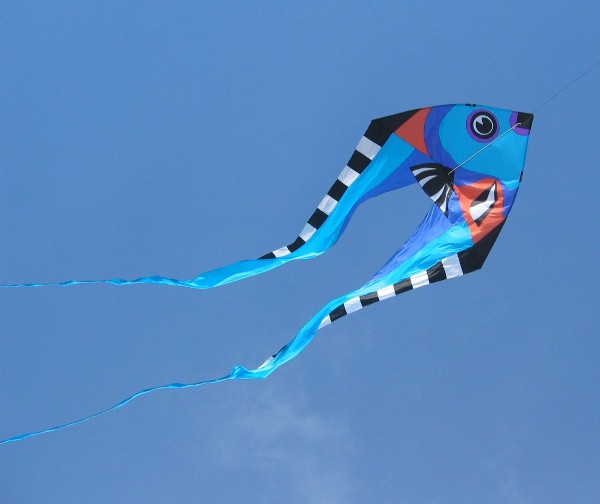
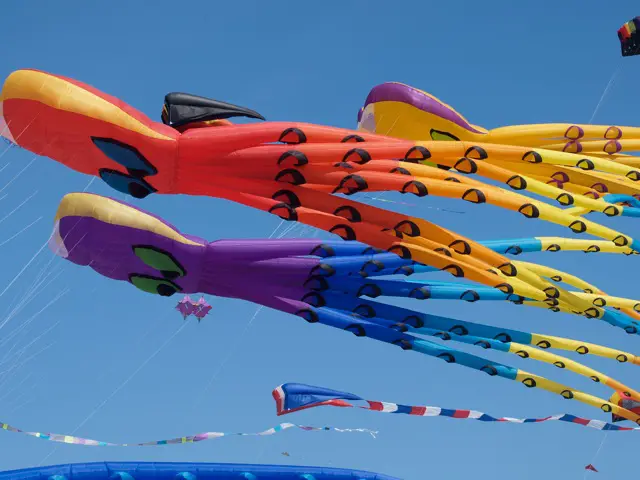




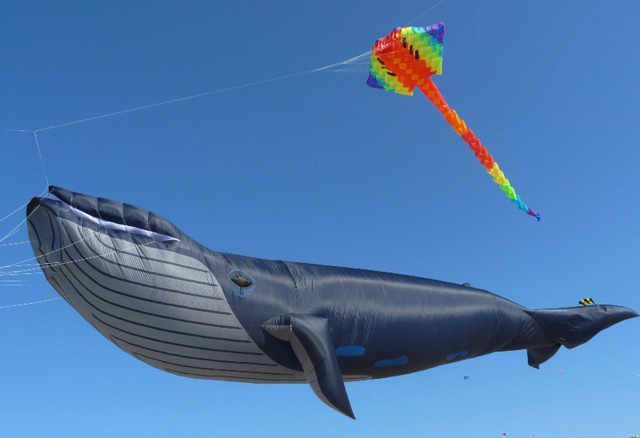





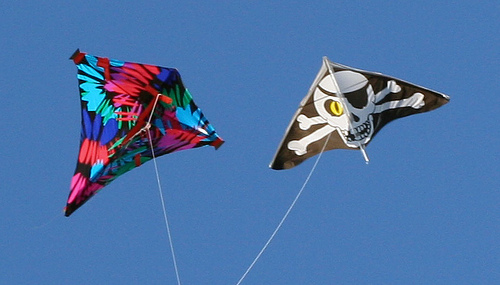

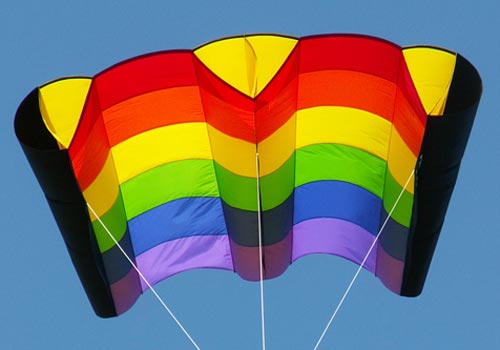
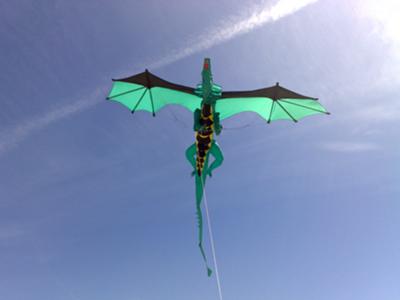


Kite Biography
Kite traction
A quad-line traction kite, commonly used as a power source for kite surfing
Kites can be used to pull people and vehicles downwind. Efficient foil-type kites such as power kites can also be used to sail upwind under the same principles as used by other sailing craft, provided that lateral forces on the ground or in the water are redirected as with the keels, center boards, wheels and ice blades of traditional sailing craft. In the last two decades several kite sailing sports have become popular, such as kite buggying, kite landboarding, kite boating and kite surfing. Snow kiting has also become popular in recent years.
Kite sailing opens several possibilities not available in traditional sailing:
Wind speeds are greater at higher altitudes
Kites may be manoeuvered dynamically which increases the force available dramatically
There is no need for mechanical structures to withstand bending forces; vehicles or hulls can be very light or dispensed with all together
The German company SkySails has developed ship-pulling kites as a supplemental power source for cargo ships, first tested in January 2008 on the ship MS Beluga Skysails.[35] Trials on this 55 m ship have shown that, in favorable winds, the kite reduces fuel consumption by up to 30%. This system is planned to be in full commercial production late 2008.[36] Kites are available as an auxiliary sail or emergency spinnaker for sailing boats. Self-launching Parafoil kites are attached to the mast.[citation needed]
MS Beluga Skysails is the world's first commercial container cargo ship partially powered by a giant computer-controlled kite (160 m² or 1,722 sq ft). The kite could reduce fuel consumption by 20%. It was launched on 17 December 2007 and was set to leave the northern German port of Bremerhaven to Guanta, Venezuela on January 22, 2008. Stephan Wrage, managing director of SkySails GmbH announced: "During the next few months we will finally be able to prove that our technology works in practice and significantly reduces fuel consumption and emissions." Verena Frank, project manager at Beluga Shipping GmbH, SkySails GmbH's partner further stated that "the project's core concept was using wind energy as auxiliary propulsion power and using wind as a free of charge energy".[37]
Power generation
See also: laddermill and High altitude wind power
Conceptual research and development projects by over a hundred entities are investigating the use of kites in harnessing high altitude wind currents to generate electricity.[38]
Delft University of Technology is developing a kite power technology demonstrator system based on a 25 m² kite generating 20 kW mechanical traction power. The system is tested regularly since January 2010.[39]
At the Katholieke Universiteit Leuven a research group is investigating the use of kites for power generation. Rather than a flexible kite, they use a rigid structure like an aircraft wing, because of its greater aerodynamic efficiency, easier control, and more predictable dynamics. A small prototype is being built.[40]
Cultural uses
Launch of ram-air inflated Peter Lynn single-line kite, shaped like an octopus and 90 feet (27 m) long.
Kite festivals are a popular form of entertainment throughout the world. They include large local events, traditional festivals which have been held for hundreds[clarification needed] of years and major international festivals which bring in kite flyers from Britain to display their unique art kites and demonstrate the latest technical kites.
Asia
Making a traditional Wau jala budi kite in Malaysia. The bamboo frame is covered with plain paper and then decorated with multiple layers of shaped paper and foil.
Kite flying is popular in many Asian countries, where it often takes the form of 'kite fighting', in which participants try to snag each other's kites or cut other kites down.[41] Fighter kites are usually small, flat, flattened diamond-shaped kites made of paper and bamboo. Tails are not used on fighter kites so that agility and maneuverability are not compromised.
In Afghanistan, kite flying is a popular game, and is known in Dari as Gudiparan Bazi. Some kite fighters pass their strings through a mixture of ground glass powder and glue, which is legal. The resulting strings are very abrasive and can sever the competitor's strings more easily. The abrasive strings can also injure people. During the Taliban rule in Afghanistan, kite flying was banned, among various other recreations.
In Pakistan, kite flying is often known as Gudi-Bazi or Patang-bazi. Although kite flying is a popular ritual for the celebration of spring festival known as Jashn-e-Baharaan (lit. Spring Festival) or Basant, kites are flown throughout the year. Kite fighting is a very popular all around Pakistan, but centered in urban centers across the country especially Lahore. The kite fights are at their maximum during the spring celebrations and the fighters enjoy competing with rivals in which one have to cut-loose the string of the kite of other, this is popularly called as "Paecha". During the spring festival, kite flying competitions are held across the country and the skies are colored with kites. As people cut-loose an opponents kites, shouts of 'wo kata' ring through the air. Reclaiming the kites, after they have been cut-loose by running after them, is a popular ritual especially among the youth (similar to scenes depicted in the Kite Runner which is based in neighboring Afghanistan). Kites and strings are a big business in the country and many types of strings are used: glass-coated strings, metal strings and tandi. However, kite flying was recently banned in Punjab due to recent motorcyclist deaths caused by glass-coated or metal kite-strings. Kup, Patang, Guda, and Nakhlaoo are some of the kites used. They vary in balance, weight and speed through the air.
In Vietnam, kites are flown without tails. Instead small flutes are attached allowing the wind to "hum" a musical tune. There are other forms of sound-making kites. In Bali, large bows are attached to the front of the kites to make a deep throbbing vibration, and in Malaysia row of gourds with sound-slots are used to create a whistle as the kite flies.[42]
A kite shop in Lucknow, India
Kites are very popular in India, with the states of Bihar, Jharkhand, Gujarat, West Bengal, Rajasthan and Punjab notable for their kite fighting festivals. Highly maneuverable single-string paper and bamboo kites are flown from the rooftops while using line friction in an attempt to cut each other's kite lines, either by letting the cutting line loose at high speed or by pulling the line in a fast and repeated manner. During the Indian spring festival of Makar Sankranti, near the middle of January, millions of people fly kites all over northern India. Kite flying in Hyderabad starts a month before this, but kite flying/fighting is an important part of other celebrations, including Republic Day, Independence Day, Raksha Bandhan, Viswakarma Puja day in late September and Janmashtami. An international kite festival is held every year before Uttarayan for three days in Vadodara, Surat and Ahmedabad.
Bermuda kite.
Weifang, Shandong, China is the kite capital of the world. China is the oldest place, probably with India where kites have been flown since antiquities. It is home to the largest kite museum in the world, the thousands of kites here have a display area of 8100 m2. Weifang hosts an annual international kite festival on the large salt flats south of the city. There are several kite museums in Japan, UK, Malaysia, Indonesia, Taiwan, Thailand and the USA.
In the olden days, Malays in Singapore, kites were used for fishing.[43]
Europe
In Greece and Cyprus, flying kites is a tradition for Clean Monday, the first day of Lent. In the British Overseas Territory of Bermuda, traditional Bermuda kites are made and flown at Easter, to symbolise Christ's ascent. Bermuda kites hold the world records for altitude and duration. In Fuerteventura a kite festival is usually held on the weekend nearest to 8 November lasting for 3 days.
Polynesia
Māori kite
Polynesian traditional kites are sometimes used at ceremonies and variants of traditional kites for amusement. Older pieces are kept in museums.
South America
In Chile, it is very popular, especially during Independence Day festivities (September 18).
In Colombia kites can be seen flown in parks and recreation areas during August which is known to be windy. It is during this month that most people, especially the young ones would fly kites.
In Guyana, kites are flown at Easter and is an activity participated in by all ethnic and religious groups. Kites are generally not flown at any other time of year. Kites start appearing in the sky in the weeks leading up to Easter and school children are taken to parks for the activity. It all culminates in a massive airborne celebration on Easter Monday especially in Georgetown, the capital, and other coastal areas. The history of the practice is not entirely clear but given that Easter is a Christian festival, it is said that the flying kite is symbolic of the Risen Lord. Moore[44] describes the phenomenon in the 19th century as follows:
A very popular Creole pastime was the flying of kites. Easter Monday, a public holiday, was the great kite-flying day on the sea wall in Georgetown and on open lands in villages. Young and old alike, male and female, appeared to be seized by kite-flying mania. Easter 1885 serves as a good example. “The appearance of the sky all over Georgetown, but especially towards the Sea Wall, was very striking, the air being thick with kites of all shapes and sizes, covered with gaily coloured paper, all riding bravely on the strong wind"
(His quotation is from a letter to The Creole newspaper of December 29, 1858). The exact origins of the practice of kite flying (exclusively) at Easter are unclear. Brereton and Yelvington[45] speculate that kite flying was introduced by Chinese indentured immigrants to the then colony of British Guyana in the mid 19th century. The author of an article in the Guyana Chronicle newspaper of May 6, 2007 is more certain:
Kite flying originated as a Chinese tradition to mark the beginning of spring. However, because the plantation owners were suspicious of the plantation workers, the Chinese claimed that it represented the resurrection of Jesus Christ. It was a clever argument, as at that time, Christians celebrated Easter to the glory of the risen Christ.
Kite

Kite

Kite

Kite

Kite

Kite

Kite

Kite

Kite

Kite

Kite

Kite

Kite
Kite

Kite

Kite

Kite

Kite

Kite

Kite

Kite

Kite

Kite
No comments:
Post a Comment